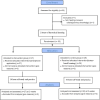Efficacy of smartphone-based Mobile learning versus lecture-based learning for instruction of Cephalometric landmark identification
- PMID: 32867758
- PMCID: PMC7457473
- DOI: 10.1186/s12909-020-02201-6
Efficacy of smartphone-based Mobile learning versus lecture-based learning for instruction of Cephalometric landmark identification
Abstract
Background: Considering the increasing popularity of electronic learning, particularly smartphone-based mobile learning, and its reportedly optimal efficacy for instruction of complicated topics, this study aimed to compare the efficacy of smartphone-based mobile learning versus lecture-based learning for instruction of cephalometric landmark identification.
Methods: This quasi-experimental interventional study evaluated 53 dental students (4th year) in two groups of intervention (n = 27; smartphone instruction using an application) and control (n = 26, traditional lecture-based instruction). Two weeks after the instructions, dental students were asked to identify four landmarks namely the posterior nasal spine (PNS), orbitale (Or), articulare (Ar) and gonion (Go) on lateral cephalograms. The mean coordinates of each landmark identified by orthodontists served as the reference point, and the mean distance from each identified point to the reference point was reported as the mean consistency while the standard deviation of this mean was reported as the precision of measurement. Data were analyzed using SPSS version 18 via independent sample t-test.
Results: No significant difference was noted between the two groups in identification of PNS, Ar or Go (P > 0.05). However, the mean error rate in identification of Or was significantly lower in smartphone group compared with the traditional learning group (P = 0.020).
Conclusions: Smartphone-based mobile learning had a comparable, and even slightly superior, efficacy to lecture-based learning for instruction of cephalometric landmark identification, and may be considered, at least as an adjunct, to enhance the instruction of complicated topics.
Trial registration number: This is not a human subject research. https://ethics.
Research: ac.ir/ProposalCertificateEn.php?id=33714&Print=true&NoPrintHeader=true&NoPrintFooter=true&NoPrintPageBorder=true&LetterPrint=true .
Keywords: Lateral cephalometry; Lecture-based instruction; Smartphone instruction.
Conflict of interest statement
The authors declare that they have no competing interests.
Figures


Similar articles
-
Assessment of automatic cephalometric landmark identification using artificial intelligence.Orthod Craniofac Res. 2021 Dec;24 Suppl 2:37-42. doi: 10.1111/ocr.12542. Epub 2021 Nov 29. Orthod Craniofac Res. 2021. PMID: 34842346
-
Efficacy of a smartphone application as an aid to enhance the instruction of radiographic differential diagnosis of maxillofacial bony lesions.J Dent Educ. 2023 May;87(5):702-710. doi: 10.1002/jdd.13167. Epub 2023 Jan 15. J Dent Educ. 2023. PMID: 36642940 Clinical Trial.
-
Cephalometric landmark variability among orthodontists and dentomaxillofacial radiologists: a comparative study.Imaging Sci Dent. 2015 Dec;45(4):213-20. doi: 10.5624/isd.2015.45.4.213. Epub 2015 Dec 17. Imaging Sci Dent. 2015. PMID: 26730368 Free PMC article.
-
A comparative evaluation of concordance and speed between smartphone app-based and artificial intelligence web-based cephalometric tracing software with the manual tracing method: A cross-sectional study.J Clin Exp Dent. 2024 Jan 1;16(1):e11-e17. doi: 10.4317/jced.60899. eCollection 2024 Jan. J Clin Exp Dent. 2024. PMID: 38314342 Free PMC article.
-
The Quality of Services of Iran University Hospitals Based on SERVQUAL's Evaluation Model: A Systematic Review and Meta-Analysis.Front Public Health. 2022 Apr 18;10:838359. doi: 10.3389/fpubh.2022.838359. eCollection 2022. Front Public Health. 2022. PMID: 35509504 Free PMC article.
Cited by
-
Mobile applications in medical education: A systematic review and meta-analysis.PLoS One. 2022 Mar 24;17(3):e0265927. doi: 10.1371/journal.pone.0265927. eCollection 2022. PLoS One. 2022. PMID: 35324994 Free PMC article.
-
Education Technology in Orthodontics and Paediatric Dentistry during the COVID-19 Pandemic: A Systematic Review.Int J Environ Res Public Health. 2021 Jun 4;18(11):6056. doi: 10.3390/ijerph18116056. Int J Environ Res Public Health. 2021. PMID: 34199882 Free PMC article.
-
The development of a serious game for laser applications in dentistry and the evaluation of dental students' satisfaction.BMC Med Educ. 2024 May 28;24(1):583. doi: 10.1186/s12909-024-05563-3. BMC Med Educ. 2024. PMID: 38807167 Free PMC article.
-
Assessment of the Acceptable Range of Lips and Chin Position in Two Different Geographical Zones of Iran among Laypersons.J Dent (Shiraz). 2024 Jun 1;25(2):169-177. doi: 10.30476/dentjods.2023.97251.2003. eCollection 2024 Jun. J Dent (Shiraz). 2024. PMID: 38962081 Free PMC article.
-
Designing and implementation of a mobile application for teaching population oral health needs assessment for dental students; a non-randomized trial.BDJ Open. 2024 Dec 22;10(1):97. doi: 10.1038/s41405-024-00287-4. BDJ Open. 2024. PMID: 39710766 Free PMC article.
References
-
- Clair KL. A case against compulsory class attendance policies in higher education. Innov High Educ. 1999;23(3):171–180. doi: 10.1023/A:1022942400812. - DOI
-
- Hunter S, Tetley J. Lectures. Why don’t students attend? Why do students attend. Melbourne: InHERDSA Annual International Conference; 1999. pp. 12–15.
-
- Bligh DA. What's the use of lectures? 5. Eastborne: Intellect books, Anatonu Rowe Ltd; 1998.
-
- Hendricson WD, Panagakos F, Eisenberg E, McDonald J, Guest G, Jones P, Johnson L, Cintron L. Electronic curriculum implementation at north American dental schools. J Dent Educ. 2004;68(10):1041–57. 10.1002/j.0022-0337.2004.68.10.tb03851.x. - PubMed
Publication types
MeSH terms
LinkOut - more resources
Full Text Sources
Research Materials

